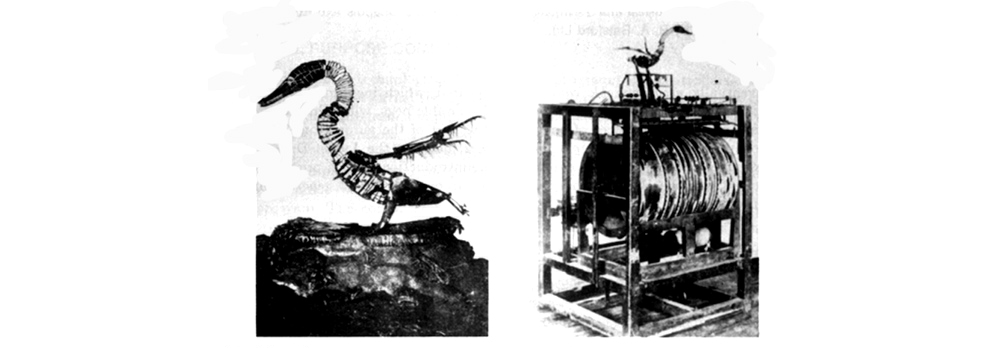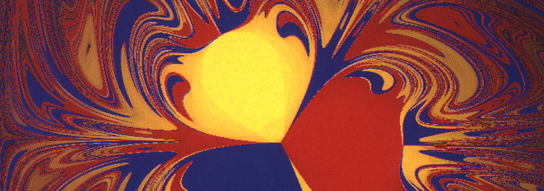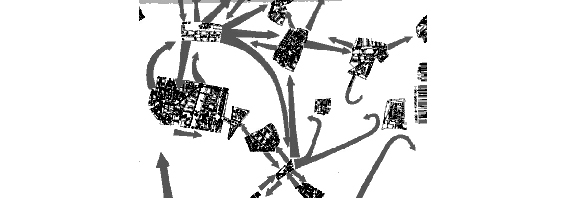"The question, at which point we draw the line between living and non-living is not a scientific question.The line between living and non-living at the beginning of evolution is arbitrary, just as the line between human and non-human primates at the end of evolution is arbitrary.The task of science is not to define the exact position of the line but to understand how it came to be crossed."
Read Morecomputation
automaton

In Aristotle's sense of the term, automaton means sheer random happening, and tyche refers to some cause and effect sequence outside the usual pattern of development. In more current usage, an automaton would be a bit of machinery exhibiting somewhat complex behavior but completely lacking in awareness. An automaton is a "self-moving" machine, and the development of control mechanisms led to the possibility of programming automata.
basin of attraction

The phase space of a particular dynamical system is partitioned into one or many basins of attraction , perhaps intimately intertwined, each with its own attractor .
basins of attraction for a pendulum swinging over three magnets. (from Peitgen, Jürgens, and Saupe, Chaos and Fractals)
Cellular Automata
Cellular Automata were invented by Stanislaw Ulam in the late 1940's and used by John von Neumann in his theoretical investigations of self- replication in machines. A cellular automaton is a lattice of finite automata that all obey transition functions defined by the local context of each cell at any given time.
Read Morecomputation
In the 1930's logicians and mathematicians like Turing, Church, Gödel, and Post contributed to the path-breaking exploration of the mechanical computational process. They became for computers what Watson and Crick would become for biotechnology. Subsequently philosophers like Hilary Putnam and Jerry Fodor developed what is now called the computational theory of the mind, in which information and computation reside in patterns of data and in relations of logic that are independent of the physical medium that carries them.
Read Moredynamics
a dynamical system consists of a space, or manifold, where the motion of the system takes place, and a rule of motion, or vector field. The starting point is called the initial state, and the path of motion the trajectory. The end point of a trajectory is the system's attractor.
hypertext city

As a conceptual framework, Hypertext provides a specific means of configuring issues sourrounding the confrontation of cyberspace and the city. It does so by embracing the advent of the electronic realm and the proliferation of networked links while at the same time interpreting these technological transformations as part of the project of writing. More specifically, studies of hypertext have focussed on the history of writing as technology, on the potential for hypertext to change the relationships between reading and writing, to alter the demarcations between the inside and outside of the text, and to change the nature and role of narrative. For its proponents, hypertext is the mode of writing that articulates the sociality of the network, that promises democratization and the empowerment of the individual, and that rearticulates themes that writing and the city have been seen to share: in the construction of memory, in the relation between movement and the subject, and in the production of space through abstraction and narrative.
Read Morehypertext

In the July, 1945 issue of The Atlantic Monthly, Vannevar Bush, who had served as the first director of the Office of Scientific Research and Development, the agency established by Roosevelt to coordinate federally funded defense research, published an article entitled "As We May Think." In it, he pointed out the increasing gap between the growing mountain of research and the inadequacies of methods for transmitting and reviewing its results, which he blamed in part on the artificiality of systems of indexing. He suggested that the human mind operates by association. "With one item in its grasp, it snaps instantly to the next that is suggested by the association of thoughts, in accordance with some intricate web of trails carried by the cells of the brain." He proposed "a mechanized, enlarged, and intimate supplement to an individual's memory, a future device" which he called a "memex" using electro-mechanical technology as a device for associative indexing, a reading and writing machine that would allow "wholly new forms of encyclopedias to appear, with a mesh of mesh of associative trails running through them." Users would create "endless trails" of links...exactly as if the physical items had been gathered together from widely separated sources and bound together to form a new book."
Read Moremapping
A "map" takes points in one space (the source space) to certain points which the map identifies as the "corresponding points" in another space (the target space). Wittgenstein calls these "logical spaces." Symbolic structures which obey a system of rules for translation are isomorphisms, structural homologies. Thus the mapping amounts to a distorted image of the source space on the target space. Language maps thought on to sound. An input/output function can be understood as a mapping. Thus the toaster executes a function mapping from bread to toast, and the groove on a gramophone record maps to the sounds. The psycho-physiological problem in mechanistic psychology becomes a problem of point-to-point mapping of mental functions such as language and memory on to the brain. (see mind /brain )
Read Morenetwork
a child's definition of a net: "a lot of holes tied together with string"
Stuart Kaufman has described the formation of networks as a phase transition that occurs as the number of connections is increased between a random graph of points. As a general feature, when the number of connections reaches half of the number of points, the majority of the points become linked in a giant cluster. Kauffman believes that we should think of the genetic program not as a serial algorithm but as a parallel distributed regulatory network .
As a general model, the network applies not only to the "intertwingled" pieces of text in a hypertext but also to the linked computers in a connected system such as Internet, to pattern-recognition systems such as the immune system, or to organisms such as the slime mold, that are made up of individual cells responding to gradients and forming larger and more differentiated entities. The ability of the brain to synchronize and coordinate activities in different parts, called reentry, is another networked process. Theorists of complexity describe the behaviour of such systems as emergent.
Problems are assumed to become intractable when they become tangled, yet models of rhizomes and networks that value links are a kind of countermodel.
Read Morereplication
Charles Darwin showed how "organs of extreme perfection and complication, which justly excite our admiration" arise not from God's foresight by from the evolution of replicators over immense spans of time. Freeman Dyson reminds us that life consists of both metabolism and replication, and that the two may have started separately. (In its pure state, replication can only be parasitic.) He subscribes to Lynn Margulis' theory that RNA is the oldest and most incurable of our parasitic diseases. (see prokaryote / eukaryote) Genetics is concerned with the replication and variation of of genes in a population (and their impact on adaptation. (See genotype / phenotype )
John von Neumann proved that a machine could be designed that could replicate itself. The logical problem is how to avoid infinite regress that would require the instructions: "how to build machine (how to build machine (how to build machine (etc.)))" If the instructions merely stated "how to build the machine" it would work once and then stop. The new machine would be unable to replicate itself.
The self-replicating machine requires a certain threshold of complexity with a controller that is able to use the same instructions for its own operation as well as for replication. Thinking of the instructions as a "blueprint" the machine is both able to carry out the instructions and copy them as separate operations.
Read Morevirtual
"Reality is that which is, 'virtuality' is that which seems to be." (Ted Nelson)
Traditionally, for something to be virtual meant that it possessed the powers or capabilities of something else. In the late 1950's, scientists developed what they called "virtual computers" -- machines quick enough to handle several users sequentially while giving each user the impression of being the only one using the computer.
In this same sense, a propagating information structure, such as a "glider" in the "game of life" (see cellular automata) is a virtual machine. For Christopher Langton, behaviors themselves can constitute the fundamental parts of non-linear systems, virtual parts, which depend on non-linear interections between physical parts for their very existence.
The Danish physicist Benny Lautrup distinguishes between "real" computer organisms and "virtual" ones. The virtual computer organisms are those designed to be completely dependent on a specific habitat inside the machine -- in games, in cellular automata, or in virtual environments such as the Tierra simulator. The environments for real computer organisms, known as computer viruses, are real computers, real hardware, mainframes, or networks.
Or is the virtual that which could be ? ......
...."Could be !"
If techno-usage stresses the dematerialized, computational capacities of the virtual, the philosophical tradition that passes through Bergson and Deleuze stresses the latent potentialities of the virtual.
Etymologically, virtual means full of virtue, virtue being taken here as the capacity to act.
Virtue / virtual / virtuous (see virtual reality ) Does the etymology of virtue from vir suggest anything?
Read Morevision
Any theory of vision must describe some relation between the eye and the brain. Humberto Maturana studied the visual cortex of the frog and summarized his research in an article entitled, "what the frog's eye tells the frog's brain." Maturana and his co-authors demonstrated that the frog's sensory receptors speak to the brain in a language that is highly processed and species specific. If every species constructs for itself a different world, which is the world? Thus Maturana's credo: There is no observation without an observer.(K. Hayles, "Simulated Nature and Natural Simulations," in Uncommon Ground.) Further research led Maturana to conclude that perception is not fundamentally representational, that the perceiver encounters the world through his own self-organizing processes, through autopoesis.
Read More